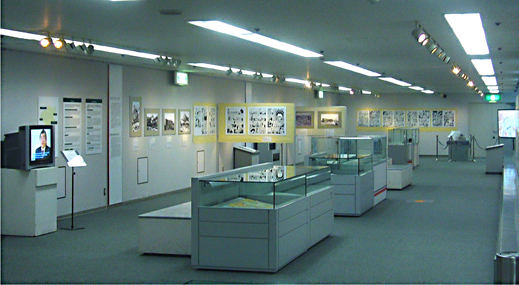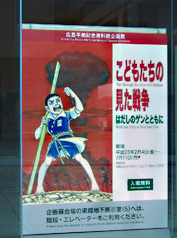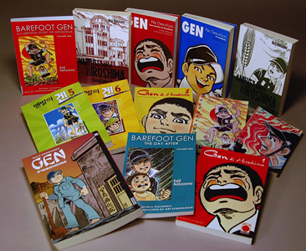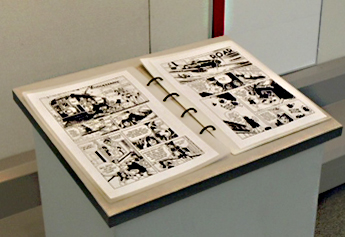 |
| View of one section of the "Barefoot Gen" exhibition, which includes manga panels, photographs, and video interviews with survivors of the atomic bomb. |
Most visitors to the Hiroshima Peace Memorial Museum are prepared to run its seemingly endless gauntlet of gut-wrenching photographs and paraphernalia chronicling the world's first atomic bombing and its aftermath. Few are likely to anticipate viewing the same events through the medium of manga, but that is just what they can do at the current exhibition in the basement gallery. On display through July 11, War through the Eyes of Children: With the Help of Barefoot Gen is a thoroughgoing retrospective of the work of cartoonist Keiji Nakazawa, a Hiroshima native who himself lived through the bombing at age six but lost most of his family in the fires that followed.
Nakazawa's magnum opus is Hadashi no Gen (translated into English as "Barefoot Gen"), a manga epic that runs to 2,500 pages and was originally serialized in various magazines in the 1970s and 1980s. Gen is an only slightly fictionalized retelling of the author's own experiences as a survivor, seen through the eyes of young Gen Nakaoka, who is clearly modeled after Nakazawa himself. (Despite some serious health problems in recent years, Nakazawa is still alive and surprisingly well at 72.)
In equal parts terrifying, hilarious, didactic, and uplifting, Gen has been translated, mostly by volunteer groups, into over 20 languages -- generally to critical acclaim despite some readers' initial skepticism about the wisdom of portraying such horrific subject matter in cartoons.
 |
|
 |
| Poster for the exhibition at the museum entrance. |
|
Barefoot Gen author Keiji Nakazawa recounts his own experience of the atomic bombing in a 1988 video interview, with English subtitles. |
I have been personally involved in the process of translating the Gen series into English, so I am not an objective critic. However, I will wager that even a complete stranger to Nakazawa and his work would be impressed by the Peace Museum's exhibition, which wisely augments its exhaustive display of manga panels with photographs depicting life in Hiroshima during and after the war, video interviews with A-bomb survivors (including Nakazawa himself, of course), and personal effects belonging to those who died in the bombing. In some respects, in fact, the exhibit is like a microcosm of the far more extensive collection of bomb-related materials upstairs, and possibly a bit more palatable for the faint of heart.
Dominating the exhibition are its wall upon wall of enlarged manga pages, offering fairly substantial excerpts from the original Gen. Fortunately for English readers, these are accompanied by strategically placed portfolio-size folders that contain the equivalent pages of the English translation. One can, in fact, absorb quite a bit of Nakazawa's saga simply by taking the time to peruse one's way through this show.
As the exhibition's title indicates, however, it is not just about Gen and its author, nor about the atomic bombing in isolation from the rest of the war experience. Rather, it seeks to provide a sense of how the war affected children in a number of ways. Hence one of the most moving and edifying sections describes the lives of schoolchildren evacuated en masse to the countryside long before August 6, when American B-29s began firebombing Japan's cities in the spring of 1945. Another section focuses on the large numbers of children orphaned and made homeless by the A-bomb. Interviews with some of these orphans, now grown, reveal how many went on to suffer twice over from discrimination and neglect at the hands of relatives, schools, and other institutions.
 |
|
 |
| Keiji Nakazawa today, at age 72. |
|
Some of the translations into various languages of the Barefoot Gen series. Image courtesy of the Hiroshima Peace Memorial Museum |
Granted, the children of Hiroshima who are the subject of this show suffered unique abominations -- nuclear attack and its radioactive aftereffects -- shared only by the children of Nagasaki. But much of their ordeal is common to the experience of children caught in war zones around the world, in any era.
Indeed, one reason for the global appeal of Gen is, I think, that the author was able to transcend the gruesome truths of his own experience and make the story a universal one of triumph over devastating odds by a very young, but very feisty, schoolboy. However unlikely it may sound, Barefoot Gen is ultimately a story of hope and survival. As Japan continues to reel from its unresolved nuclear plant crisis -- and the irony of such a disaster occurring in the only country to suffer nuclear attack is not lost on the populace -- we are badly in need of inspiring messages like those contained in Nakazawa's work. How sobering, though, to think that it takes the testimony of someone who survived a nuclear "crisis" of far more terrible proportions than the present one to put our own problems in perspective.
 |
|
 |
| A page from the first volume of the original Japanese edition of Barefoot Gen, depicting family life just before the bombing on the morning of August 6, 1945. (Click to enlarge) © Keiji Nakazawa |
|
Portfolio-size pages from the English translation of Barefoot Gen are provided as a key to the manga wall displays. Image courtesy of the Hiroshima Peace Memorial Museum
Photos by Alan Gleason unless otherwise indicated. All images by permission of the Hiroshima Peace Memorial Museum and Keiji Nakazawa. |